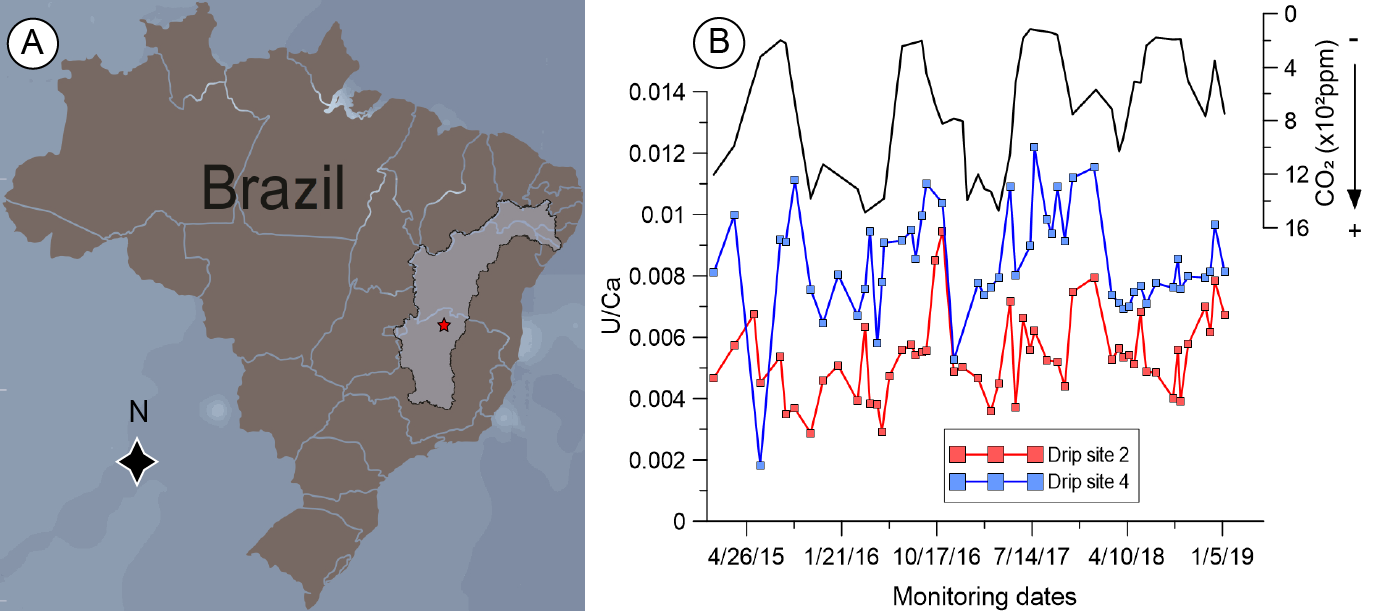- Home
- Publications
- PAGES Magazine
- Anthropogenic Effects On Climate and Hydrology of Central Brazil
Anthropogenic effects on climate and hydrology of Central Brazil
Piacsek P, Bernal JP, Raphaelli JTA, Santelli RE & Stríkis N
Past Global Changes Magazine
30(2)
119
2022
Patricia Piacsek![]() 1, J.P. Bernal1, J.T.A. Raphaelli2, R.E. Santelli3 and N. Stríkis2
1, J.P. Bernal1, J.T.A. Raphaelli2, R.E. Santelli3 and N. Stríkis2
Dr. Patricia Piacsek, from Brazil, traveled to the Universidad Nacional Autónoma de Mexico as a PAGES-IAI International Mobility Research Fellow (22 January – 1 March 2022) to study the effects of precipitation anomalies in the speleothem geochemistry, based on monitoring studies from caves located in the savannah-like biomes. Within this project, Patricia and her collaborators intend to expand our understanding of climate controls on uranium isotope composition in cave drip water and speleothems.
Increases in global average temperatures substantially impact the variability of extreme climatic events, with frequent adverse effects on the hydrological regime of the tropics. In regions with seasonal climates, such as the Brazilian Cerrado, the accumulation of negative precipitation anomalies and heatwaves increase the risk of hydrological droughts, triggering damage to ecosystems, the agricultural sector, and the entire supply chain related to it. Reconstruction of the hydrological variability beyond the instrumental series is essential to understanding the periodicity and intensity of extreme events over the natural modes of climatic variability. This allows us to better project drought risks.
Variations in trace elements in speleothems are strongly coupled with karst hydrology regime change. However, the application of trace elements in speleothems to the reconstruction of local precipitation is not yet well understood, as the complexity of the geochemical processes in the karst system hampers the possibility of a general model to explain trace-element variations. Stirling et al. (2007) showed that oxidation-reduction processes during water percolation and mineral weathering can generate considerable uranium (U) isotope fractionation. This is due to the fact that 235U fractionates from 238U during chemical reduction of uranium in ambient temperature groundwater and is preferentially incorporated into speleothems. Thus, analyses of U isotope composition in precipitated calcite on an artificial substrate of monitoring caves have the potential to allow us to estimate the appropriateness of speleothems as a proxy for external climatic conditions of the past.
Trace-element error factor
The Anjos cave is located in Central Brazil, within the São Francisco River Basin (Fig. 1a). Studies have shown that the CO2 levels within the cave are strictly dependent on the semi-deciduous vegetation above the cave (Azevedo et al. 2021; Novello et al. 2021). The development of thicker soil and denser vegetation during the rainy season (November to April) enhances the CO2 levels inside the cave. In this study, we investigated the environmental controls of U concentrations based on precipitated material on an artificial substrate at four drip sites at Anjos Cave. Drip sites 1 and 3 have intermittent drip flows, whereas the flows at drip sites 2 and 4 are continuous. However, despite these differences, the ratio of the trace elements Mg/Ca, obtained with ion chromatography with mass spectrometry (IC-MS), indicates the decay trend of the trace elements (Fig. 1b).
Under normal conditions of prior calcite precipitation (PCP), the progressive reduction of the Mg/Ca ratio would indicate an increase in regional precipitation. If the PCP modulates Mg/Ca and Sr/Ca variability, the logarithms of the molar ratios (mol Mg/mol Ca and mol Sr/mol Ca) should co-vary linearly, with a slope of 0.88 ± 0.13 (Sinclair 2011). The resulting slope (m > 1) of all drip sites indicates that processes other than PCP have an impact on the abundances of Mg and Sr in the stalagmite. Therefore, the Mg/Ca from these drip sites failed to indicate that PCP was the main driver of the observed trace-element variability. In fact, a decrease in precipitation was observed, and CO2 levels inside the cave progressively decreased.
Uranium isotopes as an alternative proxy for hydrological oscillations
In contrast to trace elements, the uranium to calcium ratio (U/Ca) of drip water showed seasonal variability throughout the record. The drip sites with distinct fracture structures on the host rock (intermittent and continuous) showed opposite trends in U/Ca concentrations. The difference between the drip points may be related to the residence time of the water percolation with the host rock. We interpret seasonal U/Ca variations from the continuous drip point as reflecting changes in the seasonal rainfall amounts, where positive ratio values seem to be related to dry periods and low CO2 levels inside the cave.
Our results suggest that the U/Ca behavior of speleothems varies as a function of the hydrology of the dripping points; this suggests that U concentration in dripping solution is strongly tied to changes in rainout, indicating that U/Ca values in speleothems from continuous drip are excellent proxies for rainfall variability. However, other competing processes, such as pre-precipitation of calcite, may lead to opposing behaviors between the dripping in response to changes in hydrology. The monitoring results are important for the reconstruction of the hydrological variability over the last few centuries in the São Francisco River Basin.
affiliationS
1Centro de Geociencias, Universidad Nacional Autónoma de México (UNAM), Mexico City, Mexico
2Departamento de Geoquímica Ambietal, Fluminense Federal University (UFF), Niterói, RJ, Brazil
3Departamento de Química Analítica, University of Rio de Janeiro (UFRJ), Brazil
contact
Patricia Piacsek: piacsekpatricia gmail.com
gmail.com
references
Azevedo V et al. (2021) Earth Planet Sci Lett 563: 116880
Novello VF et al. (2021) Quat Sci Rev 255: 106822
Sinclair DJ (2011) Chem Geol 283: 119-133
Stirling CH et al. (2007) Earth Planet Sci Lett 264: 208-225
